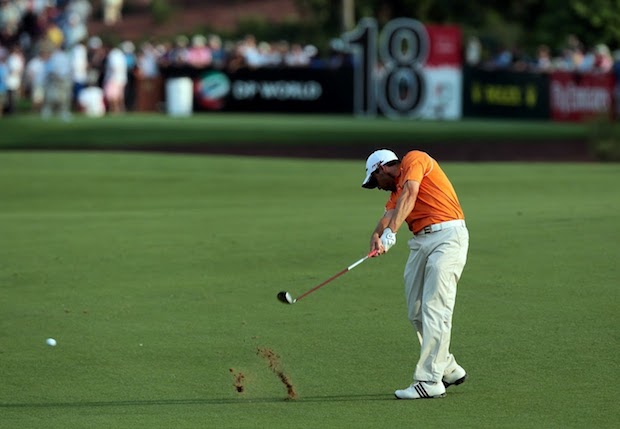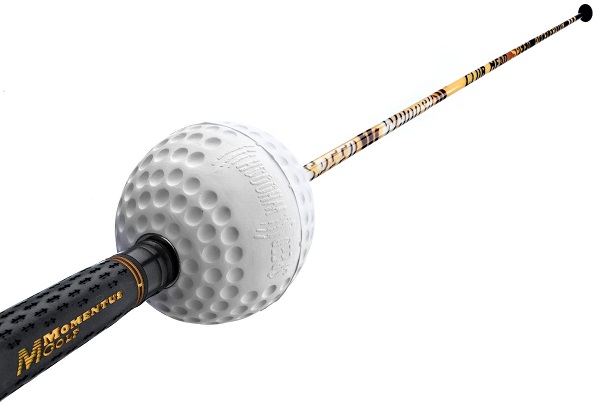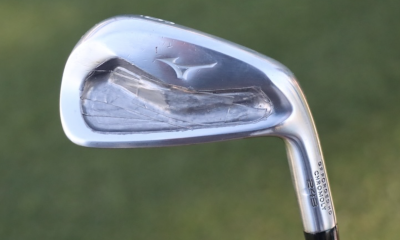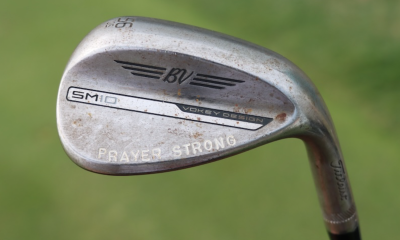Instruction
Curing excessive “lag” at impact

Technology is a wonderful thing. It is making both teachers and students better, as it allow us to understand more and more about the golf swing with the inventions of systems like 3-D Motion Analysis, Force Plates and Doppler radar launch monitors like Trackman and FlightScope. This technology has also proven to us that things we once thought were good can also be harmful if taken too far. Such is the case with clubhead lag.
When golfer transitions into the downswing, the clubhead “lags” behind the hands into delivery and snaps “inline” with the forward arm the split second before the ball separates from the blade (in a perfect world.) If you have too much lag, the shaft leans forward, delofting the club, while too little lag adds loft to the clubhead.
Long have golfers heard that they must have a flat leading wrist at impact to make their club shaft to lean forward. Golfers must have control of their impact alignments in an effort to produce the trajectories they desire, and a forward leaning club shaft can equate to more distance. However, golfers must NOT take “lag” to an extreme level or they will cause themselves several problems.
Let’s see what too much lag looks like while hitting a driver.
Whenever a golfer has too much “lag” or “handle-drag” into impact, it causes several things to happen:
- The swing’s low point is moved too far forward.
- The angle of attack becomes more downward.
- The club’s dynamic loft is reduced.
- The subsequent launch angle of the ball tends to be too low.
- The vertical impact point can be altered, thus effecting the ball’s spin rate.
- A golfer’s spin loft will be too low and his or her ball speed can be slower as well.
It’s amazing that something we once thought of as a good thing can also become bad if taken to the extreme. So, if you think you have too much “lag” in your downswing with the driver, what are the symptoms and how do you fix it? The following questions will help you identify if you in fact have too much lag.
- Do you tend to hit your driver on a flatter, lower trajectory?
- Are your impact points on the center-line of the club, not high on the face?
- Do you tend to hit push blocks?
- Does your overall distance production rely on a subsequent amount of roll?
So how do you fix this issue if you have it? In my opinion, the very best way to solve excessive lag issue is to use a training aid called the “Speed Whoosh” by Momentus Golf.
The goal of the Speed Whoosh drill shown below is to have the feeling that the impact of the rubber ball is just before impact. This will help you to feel how to release the club a touch earlier so you won’t run into the problems listed above.
Now I am certainly not telling you to have an early release, but if you consistently fight too much lag into your downswing, then this is one of the best ways to get the feeling of not “dragging the handle too much.”
Practice making swings with The Whoosh, hit a few shots, practice with The Whoosh again, hit a few shots higher and repeat the process. If you monitor the factors listed above, I bet you will reduce your excessive lag and hit the ball higher and farther than before. Give it a try and see!
- LIKE12
- LEGIT2
- WOW3
- LOL3
- IDHT1
- FLOP2
- OB0
- SHANK8
Instruction
The Wedge Guy: The easiest-to-learn golf basic

My golf learning began with this simple fact – if you don’t have a fundamentally sound hold on the golf club, it is practically impossible for your body to execute a fundamentally sound golf swing. I’m still a big believer that the golf swing is much easier to execute if you begin with the proper hold on the club.
As you might imagine, I come into contact with hundreds of golfers of all skill levels. And it is very rare to see a good player with a bad hold on the golf club. There are some exceptions, for sure, but they are very few and very far between, and they typically have beat so many balls with their poor grip that they’ve found a way to work around it.
The reality of biophysics is that the body moves only in certain ways – and the particulars of the way you hold the golf club can totally prevent a sound swing motion that allows the club to release properly through the impact zone. The wonderful thing is that anyone can learn how to put a fundamentally sound hold on the golf club, and you can practice it anywhere your hands are not otherwise engaged, like watching TV or just sitting and relaxing.
Whether you prefer an overlap, interlock or full-finger (not baseball!) grip on the club, the same fundamentals apply. Here are the major grip faults I see most often, in the order of the frequency:
Mis-aligned hands
By this I mean that the palms of the two hands are not parallel to each other. Too many golfers have a weak left hand and strong right, or vice versa. The easiest way to learn how to hold the club with your palms aligned properly is to grip a plain wooden ruler or yardstick. It forces the hands to align properly and shows you how that feels. If you grip and re-grip a yardstick several times, then grip a club, you’ll see that the learning curve is almost immediate.
The position of the grip in the upper/left hand
I also observe many golfers who have the butt of the grip too far into the heel pad of the upper hand (the left hand for right-handed players). It’s amazing how much easier it is to release the club through the ball if even 1/4-1/2″ of the butt is beyond the left heel pad. Try this yourself to see what I mean. Swing the club freely with just your left hand and notice the difference in its release from when you hold it at the end of the grip, versus gripping down even a half inch.
To help you really understand how this works, go to the range and hit shots with your five-iron gripped down a full inch to make the club the same length as your seven-iron. You will probably see an amazing shot shape difference, and likely not see as much distance loss as you would expect.
Too much lower (right) hand on the club
It seems like almost all golfers of 8-10 handicap or higher have the club too far into the palm of the lower hand, because that feels “good” if you are trying to control the path of the clubhead to the ball. But the golf swing is not an effort to hit at the ball – it is a swing of the club. The proper hold on the club has the grip underneath the pad at the base of the fingers. This will likely feel “weak” to you — like you cannot control the club like that. EXACTLY. You should not be trying to control the club with your lower/master hand.
Gripping too tightly
Nearly all golfers hold the club too tightly, which tenses up the forearms and prevents a proper release of the club through impact. In order for the club to move back and through properly, you must feel that the club is controlled by the last three fingers of the upper hand, and the middle two fingers of the lower hand. If you engage your thumbs and forefingers in “holding” the club, the result will almost always be a grip that is too tight. Try this for yourself. Hold the club in your upper hand only, and squeeze firmly with just the last three fingers, with the forefinger and thumb off the club entirely. You have good control, but your forearms are not tense. Then begin to squeeze down with your thumb and forefinger and observe the tensing of the entire forearm. This is the way we are made, so the key to preventing tenseness in the arms is to hold the club very lightly with the “pinchers” — the thumbs and forefingers.
So, those are what I believe are the four fundamentals of a good grip. Anyone can learn them in their home or office very quickly. There is no easier way to improve your ball striking consistency and add distance than giving more attention to the way you hold the golf club.
More from the Wedge Guy
- The Wedge Guy: Golf mastery begins with your wedge game
- The Wedge Guy: Why golf is 20 times harder than brain surgery
- The Wedge Guy: Musings on the golf ball rollback
- LIKE81
- LEGIT13
- WOW4
- LOL1
- IDHT0
- FLOP4
- OB1
- SHANK8
Instruction
Clement: Stop ripping off your swing with this drill!

Not the dreaded headcover under the armpit drill! As if your body is defective and can’t function by itself! Have you seen how incredible the human machine is with all the incredible feats of agility all kinds of athletes are accomplishing? You think your body is so defective (the good Lord is laughing his head off at you) that it needs a headcover tucked under the armpit so you can swing like T-Rex?
- LIKE0
- LEGIT1
- WOW2
- LOL0
- IDHT0
- FLOP0
- OB0
- SHANK2
Instruction
How a towel can fix your golf swing

This is a classic drill that has been used for decades. However, the world of marketed training aids has grown so much during that time that this simple practice has been virtually forgotten. Because why teach people how to play golf using everyday items when you can create and sell a product that reinforces the same thing? Nevertheless, I am here to give you helpful advice without running to the nearest Edwin Watts or adding something to your Amazon cart.
For the “scoring clubs,” having a solid connection between the arms and body during the swing, especially through impact, is paramount to creating long-lasting consistency. And keeping that connection throughout the swing helps rotate the shoulders more to generate more power to help you hit it farther. So, how does this drill work, and what will your game benefit from it? Well, let’s get into it.
Setup
You can use this for basic chip shots up to complete swings. I use this with every club in my bag, up to a 9 or 8-iron. It’s natural to create incrementally more separation between the arms and body as you progress up the set. So doing this with a high iron or a wood is not recommended.
While you set up to hit a ball, simply tuck the towel underneath both armpits. The length of the towel will determine how tight it will be across your chest but don’t make it so loose that it gets in the way of your vision. After both sides are tucked, make some focused swings, keeping both arms firmly connected to the body during the backswing and follow through. (Note: It’s normal to lose connection on your lead arm during your finishing pose.) When you’re ready, put a ball in the way of those swings and get to work.

Get a Better Shoulder Turn
Many of us struggle to have proper shoulder rotation in our golf swing, especially during long layoffs. Making a swing that is all arms and no shoulders is a surefire way to have less control with wedges and less distance with full swings. Notice how I can get in a similar-looking position in both 60° wedge photos. However, one is weak and uncontrollable, while the other is strong and connected. One allows me to use my larger muscles to create my swing, and one doesn’t. The follow-through is another critical point where having a good connection, as well as solid shoulder rotation, is a must. This drill is great for those who tend to have a “chicken wing” form in their lead arm, which happens when it becomes separated from the body through impact.
In full swings, getting your shoulders to rotate in your golf swing is a great way to reinforce proper weight distribution. If your swing is all arms, it’s much harder to get your weight to naturally shift to the inside part of your trail foot in the backswing. Sure, you could make the mistake of “sliding” to get weight on your back foot, but that doesn’t fix the issue. You must turn into your trial leg to generate power. Additionally, look at the difference in separation between my hands and my head in the 8-iron examples. The green picture has more separation and has my hands lower. This will help me lessen my angle of attack and make it easier to hit the inside part of the golf ball, rather than the over-the-top move that the other picture produces.


Stay Better Connected in the Backswing
When you don’t keep everything in your upper body working as one, getting to a good spot at the top of your swing is very hard to do. It would take impeccable timing along with great hand-eye coordination to hit quality shots with any sort of regularity if the arms are working separately from the body.
Notice in the red pictures of both my 60-degree wedge and 8-iron how high my hands are and the fact you can clearly see my shoulder through the gap in my arms. That has happened because the right arm, just above my elbow, has become totally disconnected from my body. That separation causes me to lift my hands as well as lose some of the extension in my left arm. This has been corrected in the green pictures by using this drill to reinforce that connection. It will also make you focus on keeping the lead arm close to your body as well. Because the moment either one loses that relationship, the towel falls.


Conclusion
I have been diligent this year in finding a few drills that target some of the issues that plague my golf game; either by simply forgetting fundamental things or by coming to terms with the faults that have bitten me my whole career. I have found that having a few drills to fall back on to reinforce certain feelings helps me find my game a little easier, and the “towel drill” is most definitely one of them.
- LIKE12
- LEGIT1
- WOW2
- LOL0
- IDHT0
- FLOP2
- OB0
- SHANK8
-

 19th Hole1 week ago
19th Hole1 week agoJohn Daly stuns fans into silence with brutal opening tee shot on PGA Tour Champions
-

 19th Hole2 days ago
19th Hole2 days agoThings got heated at the Houston Open between Tony Finau and Alejandro Tosti. Here’s why
-

 19th Hole2 weeks ago
19th Hole2 weeks ago2-time major champ announces shock retirement from the sport at age of 33
-

 19th Hole1 week ago
19th Hole1 week agoCharlie Woods finds it tough going on American Junior Golf Association debut
-

 19th Hole2 weeks ago
19th Hole2 weeks agoEdoardo Molinari reveals the latest PGA Tour golfer to turn down ‘good offer’ from LIV Golf
-

 19th Hole2 weeks ago
19th Hole2 weeks agoScottie Scheffler had an interesting response when asked how he ‘quiets the noise’ following Players victory
-

 19th Hole2 weeks ago
19th Hole2 weeks agoJon Rahm dealt fresh blow to hopes of qualifying for 2025 Ryder Cup
-

 19th Hole1 day ago
19th Hole1 day agoAddiction, spinal fusion, and scam artists – Everything Anthony Kim revealed in candid interview with David Feherty























John
Apr 28, 2016 at 8:50 pm
Great article! I’m a left handed golfer but totally right handed. My strong and dominant right arm creates extra lag as my left doesn’t kick in very well! I hit my driver very low and my miss is a push. I’m a 6 handicap. Any advice? John
WarrenPeace
Jan 1, 2014 at 2:59 pm
Tom- you are right on. I picked up a Whoosh and immediately saw that the club was releasing late by the timing of the ball so of course I had a lot of blocked shots that pushed right. Once I took some swings and started timing the ball with impact I started hitting it higher and more solid. By accident really but validates your lesson.
tom stickney
Jan 1, 2014 at 3:05 pm
Thank you…it’s a real help if you have excessive lag…I have not found too many other ways to fix it easier.
Thanks!
naflack
Jan 1, 2014 at 2:47 am
im confused…
too much lag leads to the bottom of the swing being too forward, which leads to reduced spin loft.
is this suggesting that hitting down with the driver can actually lower the spin rate?
i was taught by a trackman maestro video that hitting down with the driver doesnt necessarily increase the spin rate.
this came up in an analysis of luke donald’s driving stats, to which i was told hitting down in no uncertain terms…increases spin?
Tom Stickney
Jan 1, 2014 at 4:58 am
Not what I’m saying at all…the spinloft issue comes from a reduced angle of attack coupled with low dynamic loft and that can be a bad thing for certain types of players.
naflack
Jan 1, 2014 at 2:43 pm
i tend to make this mistake, my brain tells me i just need to release earlier, i’ll stick with that.
this spin loft/dynamic loft business is like an onion, the more layers i peel off the more it stinks and i dont like onions.
im going to do what i did with the s&t information i read, purge it and move on.
stephen lee
Dec 31, 2013 at 11:35 am
first of all, I want to thank you for all of your quality articles this year and hope for more in the coming year! and as I was reading this article, I found that in my swing,
1.The swing’s low point is moved too far ‘backward’. (results: driver launch angle of 13-14 degrees with 9.5 degrees head)
2.The angle of attack becomes more ‘upward’. (launch angle too high)
3.The club’s dynamic loft is ‘induced’. (launch angle too high)
4.The subsequent launch angle of the ball tends to be too high.
5.The vertical impact point can be altered, thus effecting the ball’s spin rate. (spin rate consistently at around 3300rpm-3600rpm range)
6.A golfer’s spin loft will be too low and his or her ball speed can be slower as well. (not sure about this one)
to tell you little bit more about my driver launch condition. when hit straight, it launches with around 140-145mph, 14-15 degrees with, 3500rpm, with max height of around 40ish yard. only carry about 235 and roll less than 10 yards. (in short, high spin, high launch angle)
am I casting my driver and does that cause it to spin too much, launch too high? I firmly believe that my launch condition is killing my distance. I know that if i have high spin, i need low launch angle and if i have low spin, i need high launch angle, but for me i have high launch angle with high spin which kills my distance. I believe with the average driver head speed of 105, if I can reduce either of my
launch angle or spin rate, i could gain about 10 yards more, please help!
finally, I wish you all the best and Happy New Year!
Tom Stickney
Dec 31, 2013 at 1:51 pm
Thank you sir. Check to see where you are hitting it on the face. Might be too low with spin numbers that high. Or it’s a fitting issue. Best thing you could do is find a fitter with TM or FS so you can see what different shafts/heads do with the correct impact points. All the best.
Mark
Dec 31, 2013 at 1:36 am
I read this article and instantly know that this all applies to me. I have a high swing speed 115-120ish and I have routinely launch the ball using a 10.5 degree driver at around 8-10 degrees. My spin was around 1200-2100 and I struggled to get the ball up. What’s even worse is that my miss has been a push, or a push hook. In addition to the Whoosh, does the Orange Whip product accomplish the same objective?
What is also funny is that when I demoed the TM SLDR, they fitted me for a 12 degree head cranked to 12.75 degrees. Only issue is my spin went up, but my launch finally got up to 14-16 haha.
Anyways, I appreciate the article Tom!
Tom Stickney
Dec 31, 2013 at 9:34 am
No. The whip tends to increase lag. If you spin the sldr too much I bet you were hitting it low on the face?? Get some dr scholl’s spray and check. All the best.
Chris
Dec 30, 2013 at 11:32 am
This is great, thanks Tom! I’ve had a low ballflight all my life that’s caused by delofting the club at impact. This is a great thought!
Jim
Dec 29, 2013 at 9:40 pm
Whoosh is also good when used in combination with a weighted club. The weighted club builds muscle/ memory while the Whoosh activates the fast twitch muscles which increases speed. You notice the difference when using both style of training aids. I read recently that you should use both to improve your swing tempo and speed and that use of only one type actually hinders your swing. Nice article.
Tom Stickney
Dec 30, 2013 at 12:32 am
I’d prefer you NOT try and use a weighted club when trying to reduce “lag.” The extra weight increases lag on the downswing and trying to release it “earlier” can lead to injury!
If you desire increased clubhead speed then use the woosh and heavy club together.
Jim
Dec 30, 2013 at 10:55 am
Thanks. I guess I was referring more to increased speed versus excessive lag. But in any case there are some great training aids available including the Whoosh and the Matzie that can help your swing and keep you sharp for the next spring season.
JKratz
Dec 29, 2013 at 8:02 pm
Cool article, but I’m guessing this only applies to about 5% of Golfwrx members (and even less for golfers in general). Most of us probably put “more lag” on our Christmas lists this year.
Tom Stickney
Dec 29, 2013 at 8:22 pm
No question…special article requested by a few wrx’ers out in computer-land.